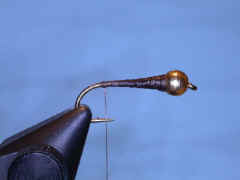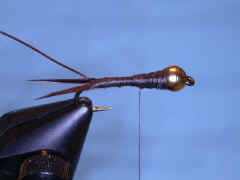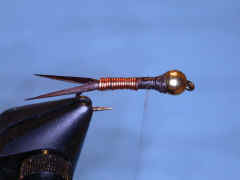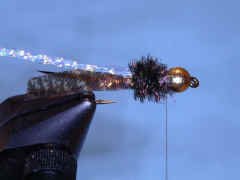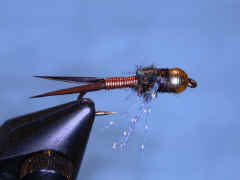|
Fly of the Month Bob Ireton brings together his experience in fly fishing, aquatic entomology, and knowledge of fly tying techniques and materials, to design and tie durable and effective flies. |

|
![]()
Volume 4, Issue 1
January 2003
![]()
COPPER JOHN VARIANT
Fly, Text, and Photography by Bob Ireton
This is a very recent fly tied by John Barr. Even though this pattern is not in most pattern books yet, I have already seen it tied several ways. Because of the bead head and copper wire body, it is a very heavy fly that will sink well for use in swift water, and deep pools. If you tie it using a curved hook and a short fiber tail, it looks like a caddis nymph. Use a straight shank hook with a biot tail, it represents a stonefly nymph. And if you use hair, filbets, etc., on the straight hook, it becomes a mayfly imitation. Use your creative imagination, and come up with your own 'variant'.
From the several sources I have read, this is a very productive fly. I also read a study that found the color 'smolt blue' is a trigger for fish, and they will readily hit a fly that has this color. With this in mind, I was using smolt blue as part of the thorax on this pattern. As I tied, I decided this crystal flash should work well for the legs. I am looking forward to trying this variation on my favorite rivers this spring.
MATERIALS
Hook - Daiichi 1560, TMC 3761, Mustad 3906B, or Orvis 167T
Size 12-18
Thread - 6/0 or 8/0 Brown
Head - Copper or Gold bead.
Tail - Brown biots.
Abdomen - Copper wire.
Wingcase - Natural mottled Bustard thin skin, and smolt blue krystal flash.
Thorax - Natural peacock herl.
Legs - Smolt blue krystal flash.TYING STEPS
| 1 - Secure the hook properly in the vice, and pinch down barb, if desired. Pick an appropriate size bead, and place on hook by guiding the hook point through the small hole of the bead. Build a base of thread wraps on the hook behind the eye, and check the fit of the bead till it is snug, and bring thread back and tie a whip finish. Cut the thread. Bring the bead forward over the thread base, all the way to the eye. Reattach the thread, and make a sloping ramp of thread to lock in the bead. Bring the thread back to form a base on the shank, and tie a half hitch over the hook barb. Apply some head cement to the thread behind the bead. | |
| 2 - Build a small ball of thread to flare the biots. Now tie in the biots, and trim butts. Take a piece of copper wire, and using flat jawed pliers, flatten down the end of the wire a distance of the shank behind the bead. Holding the wire on the bottom side of the hook shank, and touching the rear of the bead, tie in the copper wire. Bring the thread forward, stopping half way up the shank. Tie a half hitch. | |
| 3 - Palmer the copper wire in close wraps to form the abdomen. Make the abdomen 1/2 the length of the entire shank length. Cut the copper wire leaving a tag of approximately 1/8 inch. Flatten the tag with your pliers, and secure with thread wraps. Tie a half hitch. | |
| 4 - For the thorax and wing case, tie in the following order; the natural Bustard thin skin, shiny side up, several pieces of the krystal flash that has been folded on itself several times to make 12 pieces, and 3 pieces of peacock herl. | |
| 5 - Palmer the herl one piece at a time and tie off to form the thorax. Trim the butts, and tie a half hitch. | |
| 6 - Bring the krystal flash forward over the herl, and tie off. Equally divide the krystal flash 'legs', and fold rearward and downward. Tie off so the legs are in their proper location. Bring the thin skin over the thorax, and tie off to form the wing case. Trim the thin skin, and tie a half hitch and whip finish. Apply head cement. |
![]()
Copyright © 1998 - thisyear The Buckeye United Fly Fishers, Inc. Cincinnati, OH 45242
The Buckeye United Fly Fishers, Inc is a non-profit corporation organized under section 501(c)(3) of the Internal Revenue Code, incorporated in the State of Ohio for the preservation, conservation and wise use of our fishing waters and game fish; and to assist in the protection and improvement of our natural resources
